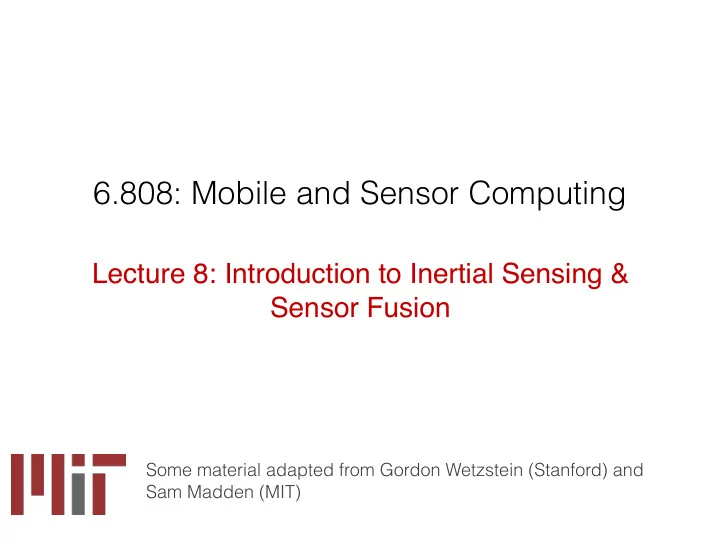

6.808: Mobile and Sensor Computing Lecture 8: Introduction to Inertial Sensing & Sensor Fusion Some material adapted from Gordon Wetzstein (Stanford) and Sam Madden (MIT)
Example Application: Inertial Navigation GPS only GPS+INS Key Idea #1: Integrate acceleration data over time to discover location (Inertial Sensing)
Inertial Sensing alone is not enough for accurate positioning • Errors accumulate over time Reference INS-alone outputs Source: INS Face Off MEMS versus FOGs Key Idea #2: Fuse Data from Multiple Sensors (Sensor Fusion)
This Lecture Key Idea #1: Integrate acceleration data over time to discover location (Inertial Sensing) Key Idea #2: Fuse Data from Multiple Sensors (Sensor Fusion)
Let’s understand inertial sensing in the context of VR • Goal: track location and orientation of head or other device • Coordinates: Six degrees of freedom: • Cartesian frame of reference (x,y,z) • Rotations represented by Euler angles (yaw, pitch roll) Source: Oculus
What does an IMU consist of? (Inertial Measurement Unit) • Gyroscope measures angular velocity ω in degrees/s • Accelerometer measures linear acceleration a in m/s 2 • Magnetometer measures magnetic field strength m in μ T (micro-Teslas). Why is it called IMU?
History of IMUs • Earliest use of gyroscopes goes back to German ballistic missiles (V-2 rocket) in WW2 for stability • In the 1950s, MIT played a central role in the development of IMUs (Instrumentation Lab)
Where are IMUs used today?
Rest of this Lecture • Basic principles of operation of different IMU sensors: accelerometer, gyroscope, magnetometer • Understanding Sources of Errors • Dead reckoning by fusing multiple sensors
How Accelerometers Work
How Accelerometers Work What matters is the displacement
k (spring constant) Hooke’s Law Newton’s Law F = ma F = kx = > a = k m x Why not simply use displacement to measure displacement?
Measuring Displacement • How do we measure displacement? • Most common approach is to use capacitance and MEMS (Micro electro-mechanical systems)
Measuring Displacement • How do we measure displacement? • Most common approach is to use capacitance and MEMS (Micro electro-mechanical systems)
MEMS Accelerometer Mass
MEMS Accelerometer Mass
+ - x Capacitor + - C = ϵ Area x
How Gyroscopes Work? The Coriolis Effect • Assume Vx • Apply ω • Experiences a fictitious force F( ω , Vx) following right hand rule
The Coriolis Effect •
How Gyroscopes Work? The Coriolis Effect • Assume Vx • Apply ω • Experiences a fictitious force F( ω , Vx) following right hand rule Can measure F in a similar fashion and use it to recover ω
How Magnetometers Work • E.g., Compass • Measure Earth’s magnetic field Measure voltage across the plate
Rest of this Lecture • Basic principles of operation of different IMU sensors: accelerometer, gyroscope, magnetometer • Understanding Sources of Errors • Dead reckoning by fusing multiple sensors
Gyroscope Measured angular velocity: Noise (Gaussian, True angular Bias zero mean) velocity • How to get from angular velocity to angle? • Integrate, knowing initial position • Linear integration? What are we missing?
Gyro Integration Angle (degrees) • Let’s plot this for gyro measurement and for orientation • Let’s include ground truth and measured data for each time (s) Consider: • linear (angular) motion, no noise, no bias • linear (angular) motion, with noise, no bias • linear (angular) motion, no noise, bias • nonlinear motion, no noise, no bias
Gyro integration: linear motion, no noise, no bias Gyro measurement (angular Actual orientation (angle vs velocity vs time) time)
Gyro integration: linear motion, noise, no bias Gyro measurement (angular Actual orientation (angle vs velocity vs time) time)
Gyro integration: linear motion, no noise, bias Gyro measurement (angular Actual orientation (angle vs velocity vs time) time)
Gyro integration: nonlinear motion, no noise, no bias Gyro measurement (angular Actual orientation (angle vs velocity vs time) time)
Gyro Integration aka Dead Reckoning • Works well for linear motion, no noise, no bias = unrealistic • Even if bias is known and noise is zero -> drift (from integration) • Bias and noise variance can be estimated, other sensor measurements used to correct for drift (sensor fusion) • Accurate in short term, but not reliable in long term due to drift
Rest of this Lecture • Basic principles of operation of different IMU sensors: accelerometer, gyroscope, magnetometer • Understanding Sources of Errors • Dead reckoning by fusing multiple sensors
Dead Reckoning • The process of calculating one's current position by using a previously determined position, and advancing that position based upon known or estimated speeds over elapsed time and course • Key things to keep in mind: • Frames of reference • Orientation change
2D Inertial Navigation in Strapdown System
2D Inertial Navigation in Strapdown System
How about 3D Rotations? • Problems? Non-commutative = order matters!
3D Rotation Representations • Rotation Matrix – 3 orthonormal vectors = 9 numbers • Euler Angles (roll, pitch, yaw) – Symmetry problem, Gimbal lock • Axis-angle • Quaternions – Hard to understand
Quaternions • 4-dimensional number
Quaternions https://youtu.be/zjMuIxRvygQ
ArmTrak (Tracking from Smart Watch) Also fuse over time through hidden markov models (HMM)
Lecture Recap • Importance of IMUs for navigation and sensing • Coordinate systems and 6DOF • IMU history and current use cases • Basic principles of operation of different IMU sensors: accelerometer, gyroscope, magnetometer • Understanding Sources of Errors • Dead reckoning by fusing multiple sensors
Recommend
More recommend